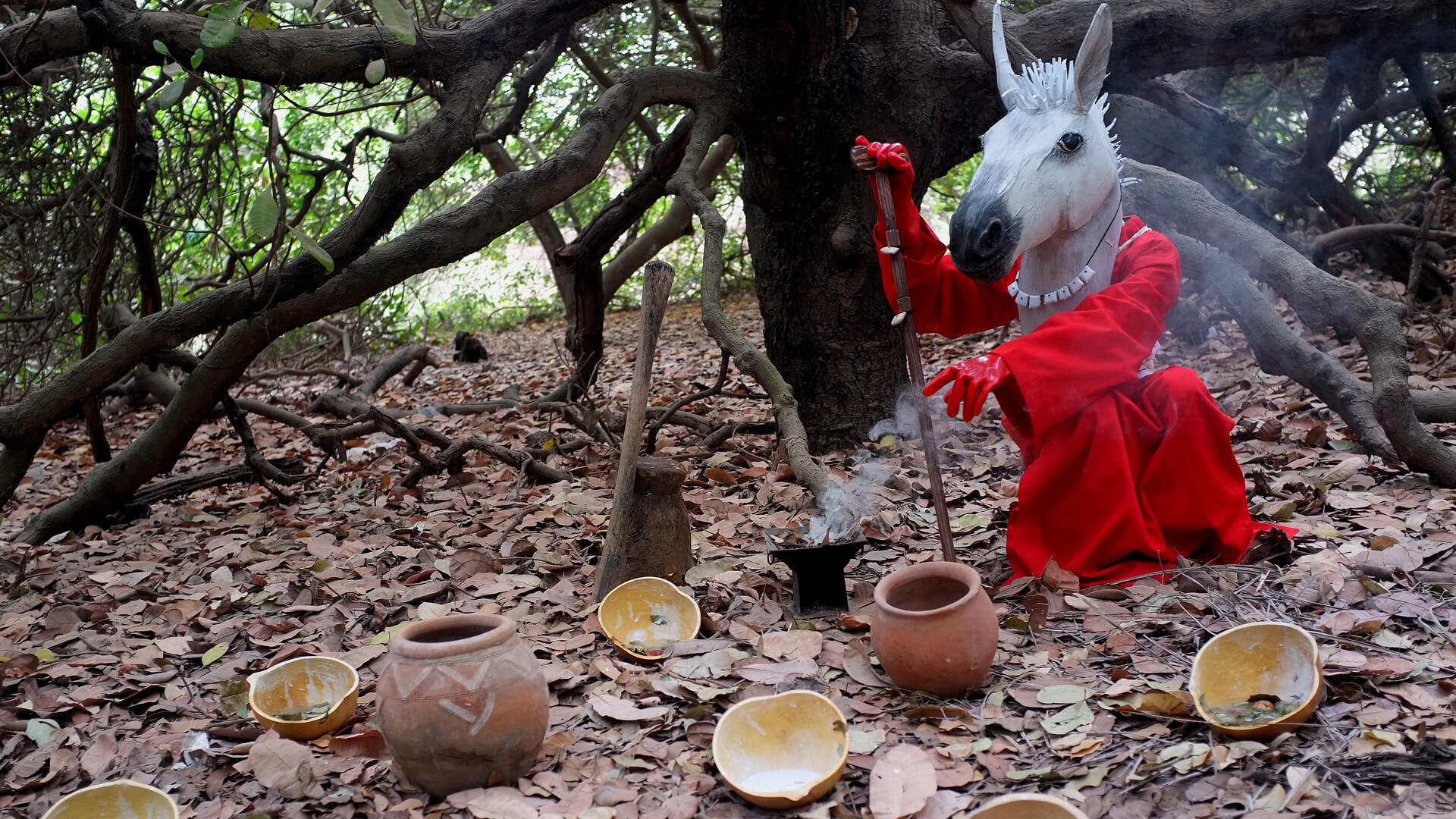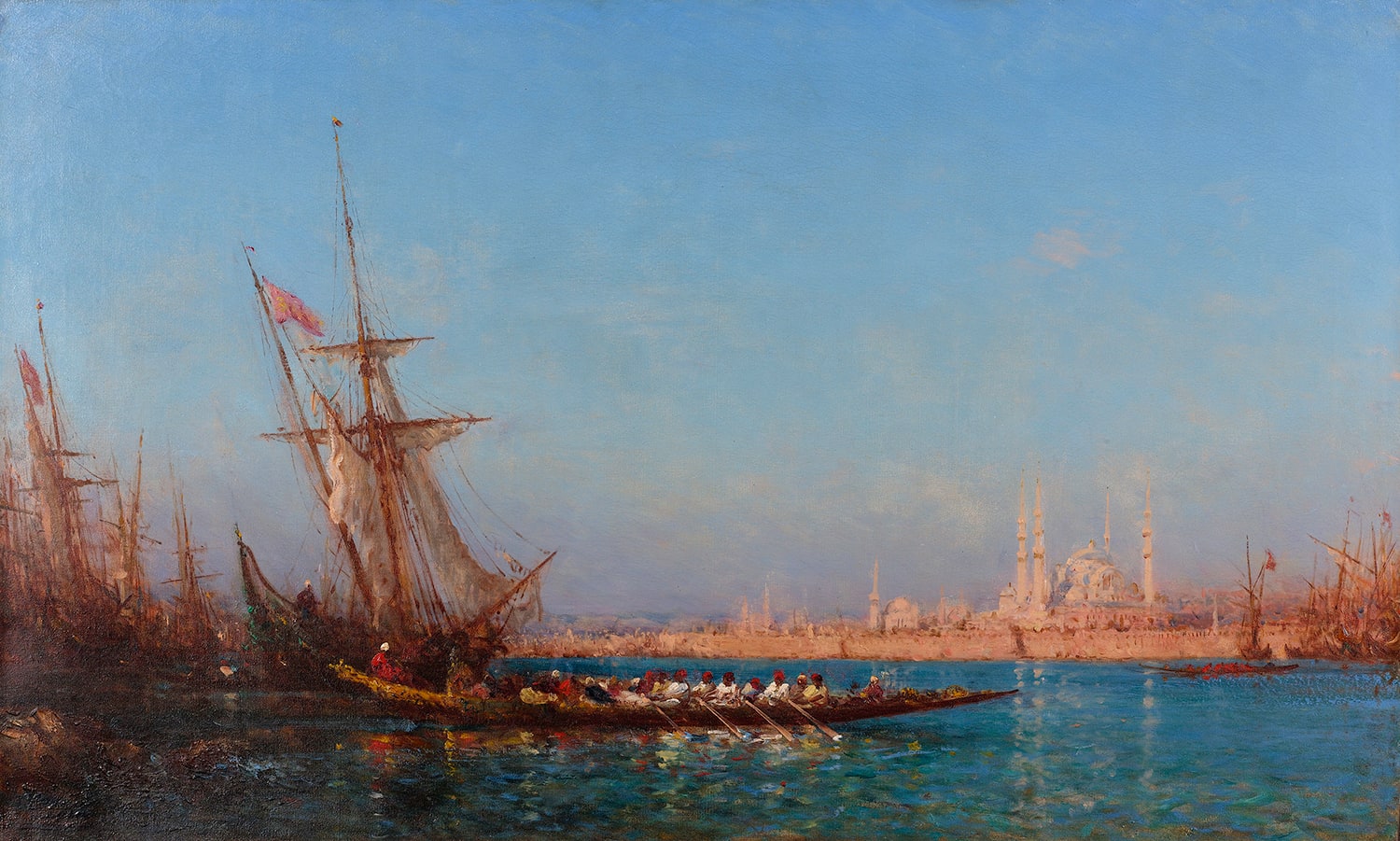Screening
December 18 - March 6, 2022
As part of the exhibition Notes for Tomorrow, Cao Guimares, Shezad Dawood and Daniela Ortiz’s films are being screened at Pera Museum’s auditorium every Saturday between December 18 – March 6, at 15:00 – 18:30.
15:00 Cao Guimares, O fim do sem fim (The end of the endless), 2001
90’
16:30 Shezad Dawood, Leviathan, Episodes 1-6, 2017-2020
101’28’’
18:10 Daniela Ortiz
CP12, 2012
Réplica, 2014
Reparación, 2017-2019
22’
Cao Guimarães
O fim do sem fim (The end of the endless), 2001
16mm/Super-8/MiniDV , 90’
Directed and edited by: Beto Magalhães, Cao Guimarães, Lucas Bambozzi
In this documentary, the directors set out on a journey through remote towns and villages in Brazil in search of crafts and professions that are near extinction. Filmed in the late 1990s and released in 2001, the work shows the imminent turn of the century, and the new millennium appears in the ominous imaginary of many outspoken characters whose “street philosophies” reflect upon a rapidly changing era. Twenty years later, the COVID-19 pandemic, a looming ecological catastrophe, and overall political and economic instability and uncertainty present a global crisis unlike any experienced before in modern times. This film helps us rethink what technological progress has brought to our lives, and how radically it has changed the social, creative and behavioral fabric of our societies.
Yet, far from a nostalgic take on romantically framed, disappearing ways of life, this film, shot in ten different Brazilian states, portrays the unique creativity, joy, and inventive power found among people with little formal education and often living in dire conditions at the margins of urban centers. Three of the most eccentric characters, self-named “masters,” remind us of medieval masterminds and innovators, or philosophers and sages that could have been roaming the streets of Athens 2,000 years ago. O fim do sem fim is as inspiring and humorous as it is political and serious. But it is also an experimental journey exploring new ways of telling stories about real life. The film is known across Brazil for its uniquely intuitive and aesthetic approach to documentary filmmaking, interweaving spontaneous narrative with carefully shot landscapes and paying careful attention to human gesture and photographic detail.
Shezad Dawood
Leviathan
Episode 1: Ben, 2017
Single screen, 12’52’’
Commissioned by University of Salford Art Collection, Outset Contemporary Art Fund and Leviathan – Human & Marine Ecology, with support from The Contemporary Art Society
Episode 2: Yasmine, 2017
Single screen, 22’10’’
Commissioned by CREAM – University of Westminster and Leviathan – Human & Marine Ecology.
Episode 3: Arturo, 2017
Single screen, 17’25’’
Commissioned by Leviathan – Human & Marine Ecology.
Episode 4: Jamila, 2018
Single screen, 10’36’’
Commissioned by Arts Council, England, Barakat, Seoul, HE.RO Amsterdam and Leviathan – Human & Marine Ecology.
Episode 5: Ismael, 2018
Single screen, 19’28’’
Commissioned by A Tale of a Tub, Rotterdam, and a Canadian partnership between Fogo Island Arts Museum of Contemporary Art Toronto, and Toronto Biennial of Art.
Episode 6: Ding Ling & Senait, 2020
Single screen, HD video, 18’46’’
Commissioned by CCA Tel Aviv, Outset Foundation for Contemporary Art, The (He)art for (He)art Program (Francisca Viudes), and Arts Council England. Image courtesy of UBIK Productions.
Leviathan is a proposal to envision a future that is very much like our present, where the boundaries of the social, political, and scientific are genuinely challenged. Historically, Leviathan is the primordial sea serpent depicted in Jewish mythology, brought to collective consciousness by Thomas Hobbes’ treatise on human nature. In Dawood’s expansion of the mythology with socio-philosophical critique, Leviathan takes the form of meditations on time, space, human nature, ecology, and the source and unfolding of life through an episodic reveal of connecting threads and contradicting realities.
Leviathan can also be associated with its roots in the Hebrew word lavah, meaning to couple, to connect and join, as the project interweaves seemingly disjointed practices and bodies of knowledge, drawing outstanding parallels between species, communities, and cultures. Based on extensive and thorough research, Leviathan is the outcome of ongoing dialogues with a wide range of marine biologists, oceanographers, political scientists, neurologists, and trauma specialists. This approach is typical for Dawood’s practice, which often involves collaboration, working with groups and individuals across different territories to physically and conceptually map far-reaching lines of inquiry.
Daniela Ortiz
CP12, 2012
Digital video, 9’56’’
Réplica, 2014
Digital video, 4’30’’
Reparación, 2017-2019
Digital video, 7’02’’
Courtesy of the artist
On each October 12 between 2012 and 2019, the artist and antiracist activist Daniela Ortiz carried out a series of actions. Set on the date of the so-called “discovery” of America, which Spain marks to celebrate its National Day, the actions reveal the imperial substrate of Spanish identity and promote counternarratives that make visible the silenced experience of the colonized peoples. This selection of videos brings together three actions carried out in the city of Barcelona. CP12, realized in collaboration with Xose Quiroga, consists of a detailed visual journey that stresses the racist ideology epitomized by the Columbus monument located in the Plaza Colón. In addition to Columbus, the monument commemorates two Catalan figures who actively participated in the colonial process, the priest Bernardo de Boyl and the soldier Pere de Margarit, who are represented next to an Indigenous man kneeling in a sign of submission.Réplica is set in Plaza Cataluña, one of the main public spaces where the National Day is celebrated. Carrying a photograph of the anonymous Indigenous man kneeling under priest Bernardo de Boyl, Ortiz kneels in front of passersby, tries to explain that the Columbus monument reifies racism, and receives some irritated and even violent reactions. In Reparación, Ortiz reads fragments of El primer nueva crónica y buen gobierno (1615), a manuscript by the Indigenous chronicler Guamán Poma de Ayala, that denounces the abuses committed by the Spanish colonizers. Immediately after the performance, the facsimile was transferred from the University of Barcelona library to a cultural space managed by migrants and racialized people. All three actions were recorded on video to be shared by the artist on social media, through which she has consistently given space to forms of anticolonial dissent beyond the art world.
Temporary Exhibition
Notes for Tomorrow features artworks from around the world, brought together to reflect on a new global reality ushered in by the Covid-19 pandemic. With the ever-present backdrop of the crisis, Independent Curators International (ICI) turned to 30 curators from 25 countries to question and reassess values and relevance in contemporary culture, and to share an artwork they believe is vital to be seen today.
Click for more information about the exhibition.


Pera Museum presented a talk on Nicola Lorini’s video installation For All the Time, for All the Sad Stones, bringing together the artists Nicola Lorini, Gülşah Mursaloğlu and Ambiguous Standards Institute to focus on concepts like measuring, calculation, standardisation, time and change.

The New Year is more than just a date change on the calendar. It often marks a turning point where the weight of past experiences is felt or the uncertainty of the future is faced. This season, Pera Film highlights films that delve into themes of hope, regret, nostalgia, and new beginnings.

Félix Ziem is accepted as one of the well-known artists of the romantic landscape painting, and has been followed closely by art lovers and collectors of all periods since. He had a profound influence on generations of artists after him, and was the first artist whose works were acquired by the Louvre while he was still alive.
Tuesday - Saturday 10:00 - 19:00
Friday 10:00 - 22:00
Sunday 12:00 - 18:00
The museum is closed on Mondays.
On Wednesdays, the students can
visit the museum free of admission.
Full ticket: 300 TL
Discounted: 150 TL
Groups: 200 TL (minimum 10 people)